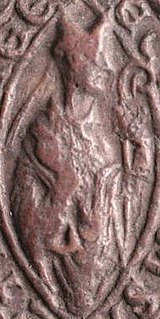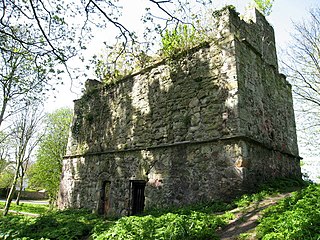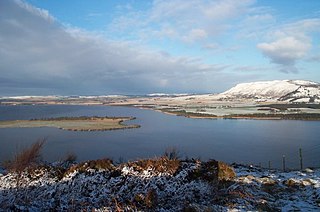Related Research Articles

Dryburgh Abbey, near Dryburgh on the banks of the River Tweed in the Scottish Borders, was nominally founded on 10 November (Martinmas) 1150 in an agreement between Hugh de Morville, Constable of Scotland, and the Premonstratensian canons regular from Alnwick Abbey in Northumberland. The arrival of the canons along with their first abbot, Roger, took place on 13 December 1152.
Fothad II was the bishop of St Andrews (1059–1093) for most of the reign of King Máel Coluim III mac Donnchada. Alternative spellings include Fodhoch, Fothach and Foderoch, and Fothawch. A "Modach filius Malmykel" is mentioned in a grant, dated 1093, as the bishop of S. Andrews. As this bishop is certainly Fothad II, his father was a man named Máel Míchéil.
Máel Ísu I is the third alleged Bishop of Cennrígmonaid, equivalent to latter day St Andrews. He is mentioned in the bishop-lists of the 15th-century historians Walter Bower (Malisius) and Andrew of Wyntoun (Malice) as the successor of Fothad I, and it is claimed that he reigned as bishop for eight years. If Máel Ísu's predecessor did get expelled from the bishopric in 955,, and if Máel Ísu's reign really was eight years, then Máel Ísu would have held the bishopric between the years 955 and 963.
Túathal is the ninth Bishop of St Andrews. He is mentioned in the bishop-list of the later medieval historian Walter Bower as the successor of Bishop Máel Dúin. Túathal's name, like his immediate predecessor Máel Dúin's, is known from other sources. A charter preserved in the Registrum of the Priory of St. Andrews, although probably translated into Latin from Gaelic at a later date, records a grant of the lands and church of Scoonie by Bishop Túathal (Tuadal) of St. Andrews to the Céli Dé of Loch Leven. Bower says that Túathal ruled as bishop for four years; as his successor Máel Dúin is known to have died in 1055, this would put his episcopate at roughly between the years 1055/6 and 1059/60. Túathal's immediate successor was the famous Bishop Fothad II.
Beóán of Mortlach is the first of the three known Bishops of Mortlach. His name, which could also be written in non-Gaelic contexts as Beanus, Beoanus and Beyn, means "lively one". Walter Bower, following John of Fordun, tells us that the bishopric was founded by king Máel Coluim II of Scotland in the seventh year of his reign as thanks to God for victories over the Scandinavians, and tells us that "the first bishop was Beyn, a saintly man, worthy of the episcopal office, elevated to this see by the Lord Pope Benedict VIII at the king's request". The Aberdeen Registrum records a charter granted to Bishop Beóán by King Máel Coluim at Forfar, granting the bishop the churches and lands of Clova and the unidentified Dulmech. The Aberdeen Breviary commemorated "Bishop Beóán" as a saint on 26 October. Another Beóán, perhaps the one mentioned in the Life of St. Cathróe of Metz, was commemorated on 16 December, and the two were often confused.

Guillaume or William de Malveisin was Chancellor of Scotland, Bishop of Glasgow (1199/1200–1202) and then Bishop of St. Andrews (1202–1238).
The Prior of St Andrews was the head of the property and community of Augustinian canons of St Andrews Cathedral Priory, St Andrews, Fife, Scotland. It was established by King David I in 1140 with canons from Nostell Priory, West Yorkshire. It is possible that, initially at least, the prior of St Andrews was subordinate to the bishop as abbot, but by the 13th century the canons of St Andrews were given freedom by the bishop to elect their prior. By the end of the 13th century, the abbacy of the native canons was no longer there to challenge the position of the priory, and the native canons themselves had been formed into a collegiate church.
Clement was a 13th-century Dominican friar who was the first member of the Dominican Order in Britain and Ireland to become a bishop. In 1233, he was selected to lead the ailing diocese of Dunblane in Scotland, and faced a struggle to bring the bishopric of Dunblane to financial viability. This involved many negotiations with the powerful religious institutions and secular authorities which had acquired control of the revenue that would normally have been the entitlement of Clement's bishopric. The negotiations proved difficult, forcing Clement to visit the papal court in Rome. While not achieving all of his aims, Clement succeeded in saving the bishopric from relocation to Inchaffray Abbey. He also regained enough revenue to begin work on the new Dunblane Cathedral.
Donald Elmslie Robertson Watt FRSE was a Scottish historian and Professor Emeritus at St Andrews University.

Radulf was a 13th-century Scoto-Norman Cistercian monk and abbot. Most details about Radulf's career and all details about his early life are not known. His earliest certain occurrence in history is his appearance as Abbot of Kinloss in a Melrose charter datable to between 1202 and 1207. It is not known for certain when he became abbot of Kinloss Abbey, but the last known abbot of Kinloss, also called Radulf, left Kinloss in 1194 to become abbot of Melrose, putting Radulf II's succession somewhere between 1194 and 1207. Written in the margins next to Radulf's obituary is the assertion that he was the 4th Abbot of Kinloss, and if these are accurate, Radulf II would have succeeded not long after Radulf I's departure to Melrose Abbey in 1194.
Odo Ydonc was a 13th-century Premonstratensian prelate. The first recorded appearance of Odo was when he witnessed a charter by Donnchadh, Earl of Carrick, on 21 July 1225. In this document he is already Abbot of Dercongal, incidentally the first Abbot of Dercongal to appear on record.
John Woodman [Wodman] was a 15th-century churchman based in the Kingdom of Scotland. Woodman was a canon of the diocese of St Andrews, and as such was locally made Prior of Pittenweem on the death of the previous prior, James Kennedy, Bishop of St Andrews; however, he was opposed by one Walter Monypenny, while the new bishop, Patrick Graham, desired the position for himself. Woodman had lost litigation for this post to Monypenny by 17 September 1466, and possession to the bishop, though Woodman was still claiming this priory as late as 1477 when he became Bishop of Ross.
Jonathan was a churchman and prelate active in late twelfth- and early thirteenth century Strathearn, in the Kingdom of Scotland. He was the Bishop of Dunblane during the time of Gille Brigte of Strathearn, and it was during Jonathan's episcopate that Gille Brigte founded an Augustinian priory at Inchaffray.
Bernard was a Tironensian abbot, administrator and bishop active in late 13th- and early 14th-century Scotland, during the First War of Scottish Independence. He first appears in the records already established as Abbot of Kilwinning in 1296, disappearing for a decade before re-emerging as Chancellor of Scotland then Abbot of Arbroath.

James Haldenston or James Haldenstoun was an Augustinian churchman from 15th-century Scotland. Probably from somewhere in eastern Fife, Haldenston became an Augustinian at St Andrews, earned several degrees on the continent, and became prior of May before becoming prior of St Andrews, head of the wealthiest and most important religious house in Scotland.

Robert I or Robert of Nostell was a 12th-century Anglo-Norman Augustinian churchman, the first prior of St Andrews.

St. Mary's Priory, North Berwick, was a monastery of nuns in medieval East Lothian, Scotland. Founded by Donnchad I, Earl of Fife around 1150, the priory lasted for more than four centuries, declining and disappearing after the Scottish Reformation. It had been endowed by the Earls of Carrick as well as the Earls of Fife, but over time lost its dependence on these and came to be controlled by the more locally based Home family, who eventually acquired the priory's lands as a free barony.
Walter I was a 12th-century Augustinian Anglo-Norman prelate active in the kingdom of Scotland.
Gilbert was a 12th-century Augustinian canon. Active in Scotland, he may have been of Anglo-Norman origin.

Simon was a 13th-century Augustinian canon based in the Kingdom of Scotland.
References
- MacQueen, John; MacQueen, Winifred; Watt, D. E. R., eds. (1995), Scotichronicon by Walter Bower, in Latin and English: Volume 3, Books V and VI, Scotichronicon by Walter Bower: New Edition in Latin and English with Notes and Indexes (General Editor D. E. R. Watt), Aberdeen: Aberdeen University Press, ISBN 1-873644-49-3
- Watt, D. E. R.; Shead, N. F., eds. (2001), The Heads of Religious Houses in Scotland from Twelfth to Sixteenth Centuries, The Scottish Record Society, New Series, Volume 24 (Revised ed.), Edinburgh: The Scottish Record Society, ISBN 0-902054-18-X, ISSN 0143-9448